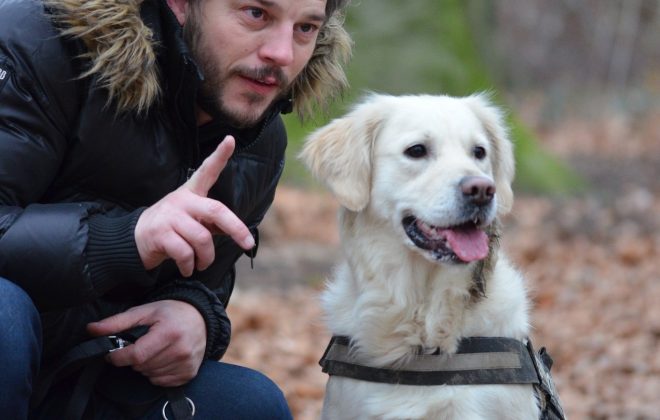Dog Trainer in Shawnee, KS shares his thoughts on a session I had today
 I worked with a dog this morning, a cute young (barely a year old) that was just as crazy as a “march hare” and was almost unable to pay attention outside. We were working on recall or come when called on a long line. The basic idea every time I call you, and you come to see me, you get a yummy treat, and we build from there! Unfortunately, this little girl was so distracted by the outside world she could not take her senses away from the environment long enough for me to reward her for checking in with me. So it gave me a great idea… I will share with you all the same articles and ideas I will share with my client! Hopefully, we all end up a little smarter in the way of speaking, dog!
I worked with a dog this morning, a cute young (barely a year old) that was just as crazy as a “march hare” and was almost unable to pay attention outside. We were working on recall or come when called on a long line. The basic idea every time I call you, and you come to see me, you get a yummy treat, and we build from there! Unfortunately, this little girl was so distracted by the outside world she could not take her senses away from the environment long enough for me to reward her for checking in with me. So it gave me a great idea… I will share with you all the same articles and ideas I will share with my client! Hopefully, we all end up a little smarter in the way of speaking, dog!
Today’s article “The Living room Dog!”
(Better Hold on. There will be about eight articles in this Series)
The Living Room Dog…
Tonight, in class, one of my students gave me inspiration for this article with one simple question. Why does my dog do all the exercises and behaves so well at home, yet completely fall apart when we try the same stuff on his walk? Simple, I said, “You have a Living Room Dog!”
Okay, let me try to make sense of this last statement. Let’s start with the fact that there are 3 D’s in dog training; Duration, Distance, and Distraction, and the realization that you have to do them in that order for success. For example, I must first teach Fido a solid 30-second duration stay, and only then do I add, let’s say, 6 feet of distance. Only when I have both duration and distance under my belt and working well will I dream of adding the last and toughest “D”, DISTRACTION. Now, how and why we use and adapt the 3 D’s in training could be its own separate article; but suffice it to say that Distractions are the hardest thing any person will ever have to deal with when training their dog…not to mention it is the starting point in creating a “Living Room” Dog
The next thing you need to understand about the “LIVING ROOM” Dog is the fact that dogs do not, cannot, and will not generalize training the way we humans understand the concept of generalization. If I teach my son to hit a baseball in a batting cage, chances are he will be able to take that skill to a new environment, let’s say, a baseball diamond. Unfortunately, dogs oftentimes do not have this ability. Teaching a dog a skill in one environment and expecting it to translate into a different situation or place is just not going to happen in most instances. A good example is that crazy dog that can fetch and retrieve toys inside the house perfectly but could care less about the game in the backyard. Why is that, do you suppose? Maybe it’s not the fact he/she could care less, and it’s more the fact they have not learned the game in that particular situation or environment.
Each week you go to class, you go home with your head full of great ideas. You practice every morning before work; you come home and practice every night, and everything seems to be going great. That is, until that one night, you decide to take Fido for a walk (instead of practicing in the Living Room), and all hell breaks loose! Fido doesn’t listen, won’t sit, barks at everything, and generally acts like the goon you had before you started classes. You are embarrassed, not to mention frustrated, and probably a little P.O.’d. This brings us (full circle) to you or my student standing in front of me or any other trainer and pleading to know why your dog falls apart outside the house. Like it or not, you just met the “LIVING ROOM” Dog!
The problem was not your dog or you. It was the fact that you forgot, or were not taught, about the two critical aspects of training discussed earlier…Distractions and Generalizations. You mistakenly thought your dog would take the things learned in the living room and translate them to the world outside their living room! As you are now beginning to realize (or maybe remember), the outside world is very distracting. The only way to make a dog reliable in all situations…is to practice in all situations. So I hope you take heed to these ideas and are ready to go after training in a slightly different way. If not, it is likely that you will also complain about having a “LIVING ROOM” Dog and be one of the many people who only experience the well-behaved and smart dog in your living room. Personally, I would prefer to experience life with an “EVERYWHERE” Dog!
Tags In
Related Posts
Search Blogs
Most Popular Posts
Best Selling Books
K.I.S.S. Dog Training proudly serves the Kansas City Metro, Overland Park and Surrounding Areas. 40 miles, 20 miles each way from Shawnee, KS is included for In-Home Sessions... Over that mileage is an additional charge of $1.00 per mile... Call with Questions
Contact Us Today!
K.I.S.S. Dog Training
Shawnee, Kansas
(913) 269-7595





